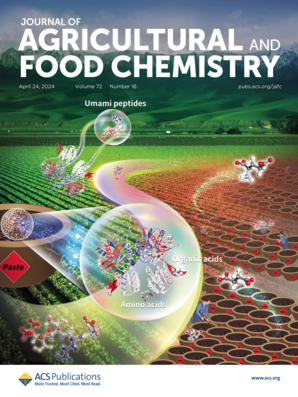Structure-Guided Engineering of Carbonyl Reductase LbCR to Simultaneously Enhance Catalytic Activity and Thermostability toward Bulky Ketones
IF 5.7
1区 农林科学
Q1 AGRICULTURE, MULTIDISCIPLINARY
引用次数: 0
Abstract
(S)-2-Chloro-1-(2,4-dichlorophenyl)ethanol ((S)-TCPE) is an important building block for the synthesis of antifungal drug luliconazole. Herein, a carbonyl reductase (CR) from Levilactobacillus brevis (LbCR) was identified for synthesis of (S)-TCPE. Through comprehensive Ala scanning and site-saturated mutagenesis (SSM) targeting the residues surrounding the substrate-binding pocket, the “best” variant LbCRM4 (N96V/E145A/A202L/M206A) was developed, which displays a 26.0-fold increase in catalytic activity, 83.5-fold enhancement in half-life (t1/2) at 40 °C (101.4 h), excellent enantioselectivity (>99.9% e.e.), and broad substrate scope. Compared to the wild-type (WT) LbCR, catalytic efficiency (kcat/KM) of LbCRM4 was increased by 28.0 folds. Furthermore, a high concentration of TCAP (400 g/L) can be transformed (99.9% conversion) within 7 h by using LbCRM4 and an isopropanol/alcohol dehydrogenase/NADPH cofactor regeneration system, giving (S)-TCPE in >99.9% e.e., which is the highest recorded space–time yield (STY, 1288.9 g/L/day) to date. Molecular dynamics (MD) simulations and dynamic cross-correlation matrix analysis elucidated the substantial catalytic performance improvement of LbCRM4. Together, the development of LbCRM4 not only overcomes the trade-offs between catalytic activity and thermostability but also affords an efficient biocatalytic approach for the synthesis of (S)-TCPE featuring a record STY, laying a solid foundation for industrial manufacturing of luliconazole and other active pharmaceutical intermediates.

求助全文
约1分钟内获得全文
求助全文
来源期刊
CiteScore
9.90
自引率
8.20%
发文量
1375
审稿时长
2.3 months
期刊介绍:
The Journal of Agricultural and Food Chemistry publishes high-quality, cutting edge original research representing complete studies and research advances dealing with the chemistry and biochemistry of agriculture and food. The Journal also encourages papers with chemistry and/or biochemistry as a major component combined with biological/sensory/nutritional/toxicological evaluation related to agriculture and/or food.

 求助内容:
求助内容: 应助结果提醒方式:
应助结果提醒方式:


